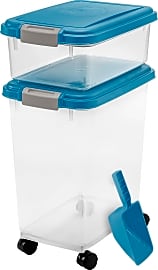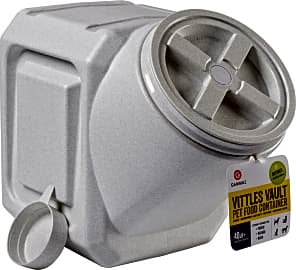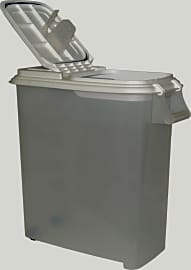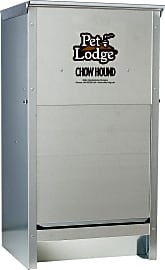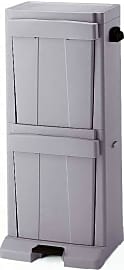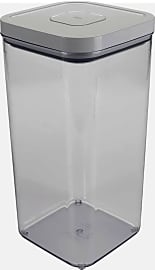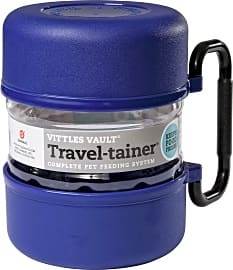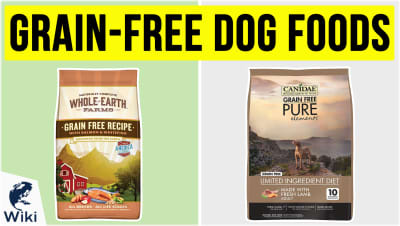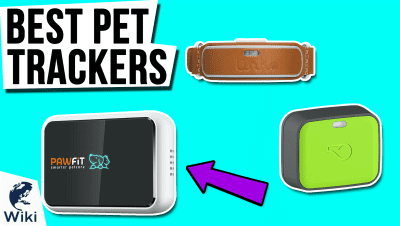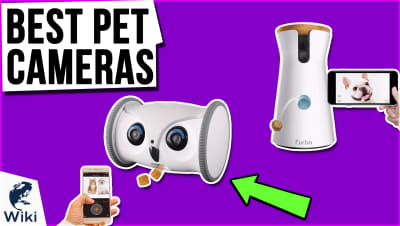The 10 Best Pet Food Containers

This wiki has been updated 42 times since it was first published in September of 2015. Owning a dog is one of life's greatest pleasures, but finding somewhere to store all of its dry kibble can be a real pain, especially when space is limited. Offering compact and durable designs, our versatile selection of pet food containers can keep Fido (or Kitty's) chow from going stale, while preventing them from snagging any extra grub outside of normal mealtimes. When users buy our independently chosen editorial selections, we may earn commissions to help fund the Wiki.
Editor's Notes
April 17, 2020:
When investing in a pet food container, storage capacity, seal quality, and available space are among the most important considerations. I happen to feed my dogs an organic diet that includes a lot of wet ingredients in addition to their standard grain-free kibble, like sweet potatoes, greek yogurt, and other refrigerated food as a complement. I do this to ensure a balanced diet and to give my pups something different, so they don't always have to endure the same boring crunchy stuff every day. That being said, I still need a place to store that dry stuff.
I personally own a version of the Vittles Vault Outback, so I can attest to the fact that it creates a reliable airtight seal when I bring home a new bag of chow. The food smells just as fresh when I get down to the very bottom of the bin as it did when I first poured the bag inside it. The lid is also easy to spin off and secure. We've also included the Simplehuman Storage Can due to its durable construction and built-in wheels for easy transport. The Iris 3-Piece Combo is also a wheeled option with a stackable design, which definitely comes in handy if the storage space in your home is limited.
Thanks to its extra-tall profile, the Buddeez Roll-Away can accommodate a 40-pound bag of dry dog food without the need to empty the contents directly into the bin. Instead, this container can hold the manufacturer's original packaging, while keeping its contents sealed and fresh.
Now, the Chow Hound Pet Lodge may look like something that belongs on a farm (and it can certainly be used on one), but it's also a good way to give multiple pets the freedom to access food on their own when you're not around.
For those with little or no floor space, the Bergan Wall Mounted Dispenser is a practical choice, as it can hold as much as many of our other options. We've also added the Vittles Vault Travel-Tainer for those with an adventurous spirit who want to make sure their furry friend can have access to fresh food and water while on the go.
While it's not solely a food container in the strictest sense, we've also added the OurPets Store-N-Feed because it's essentially an all-in-one storage and feeding solution. I own one of these and find it quite convenient. The top section lifts off very smoothly to reveal the interior storage space and the bowls clean up nicely in the dishwasher or you can wash them by hand.
Special Honors
Rescue Bank As a signature program of GreaterGood.org, Rescue Bank delivers grants to the animal rescue community in the form of donated pet food, which gets delivered through the program's network of regional affiliates. These grants essentially make it easier for various rescue organizations to reallocate their food budgets to other services like spay/neuter campaigns, veterinary services, facility maintenance, and adoption events. rescuebank.org
Keeping Fido's Kibble Fresh And Accessible
Even a resealable bag or pouch is no substitute for a container dedicated to keeping dry food fresh.
People who own a dog or a cat understand the value of the relationship formed between human and animal. As guardians of these creatures, we are responsible for their welfare and happiness, which they reciprocate in their relentless devotion to us and our way of life. It is a relationship that transcends time, location, and social boundaries. Besides love and proper veterinary care, food is the remaining piece of the puzzle to ensuring the complete well-being of one's pet. With this in mind, maintaining the right storage solution for that dry kibble is an important aspect of your pup's health.
While the majority of pet food containers come in a variety of shapes and sizes, the most common and popular materials used for their construction include plastic, metal, and glass, each of which maintains an airtight seal for preserving freshness. Heavy-duty and durable plastic containers easily withstand impacts and pups who are prone to destructive chewing. Depending on their designs, they're also equipped with multiple compartments, making them beneficial for storing treats and food in the same container. Some high-volume plastic containers include built-in wheels on their bases, making them easy to roll from the pantry to the kitchen without the concern for heavy lifting. Metal containers are ideal for bulk storage of dry kibble, often featuring removable inner buckets for easy access, serving, and cleaning. Glass containers aren't considered as practical of a storage solution as their plastic or metal competition because of their weight and potential to shatter when dropped. But a glass jar is a compact, space-saving alternative for a small breed dog or cat who doesn't consume as much food over time.
Depending on their overall weight, large breed dogs typically eat between two and four cups of kibble per day. This creates the need to purchase big bags of food as an alternative to constantly running to one's local pet store to buy extra quantities of the stuff. Considering that the majority of food packaging is designed to be lightweight to minimize shipping costs, that doesn't necessarily make it ideal for the long-term storage of a pet's meals, especially once the packaging has been opened. Even a resealable bag or pouch is no substitute for a container dedicated to keeping dry food fresh. Use of the storage container extends the shelf life of most dry dog foods.
Many varieties of kibble also contain fats and oils easily susceptible to oxidation and molding, even when you can't see the effects of such processes taking place. Using a pet food container provides an additional line of defense to ensure that a pup's food not only stays fresh, but that it maintains its nutritional value while in storage. Finally, the pet food container deters pests, like ants and other insects with a tendency to infiltrate the pantry when you least expect it.
Making Meal Times Convenient, Easy, And Safe
There are several things to keep in mind when deciding on the right container for your pet's food. You must realize that not every pet is created equal, meaning that each breed and size has different preferences and nutritional requirements. For that reason, considering the container's size and ability for stacking is beneficial, particularly if you have multiple dogs and cats around the house. Stacked and even wall-mountable containers allow you to fit a higher volume of dry foods in a small space, as opposed to keeping three separate bulky food bins in a small pantry. If you plan to keep your container downstairs in the garage, built-in wheels will make it easy to move around.
Should you decide to invest in a plastic container, make sure the material is BPA-free to prevent any dangerous chemicals from getting into your pet's food source. The plastic should be strong enough to maintain an airtight seal and to withstand extreme temperatures if you plan to leave the bin outdoors. Some plastic containers also have anti-microbial properties integrated into their designs, minimizing the accumulation of bacteria and bad odors over time.
Additional conveniences include built-in top or side handles to make your job easier when toting the bin around the house, and easy-pour tapered tops for serving a herd of hungry pooches directly from the container itself. Finally, you should be certain that the opening to your container makes it easy to scoop the kibble out and to refill when necessary.
A Brief History Of Pet Food Containers
While the domestication of pets has a long history dating back thousands of years, the pet food container does not have a definitive point of origin attributed to a single person. However, consideration of the pet diet was first mentioned by Roman scholar and philosopher Marcus Terentius Varro in his farming manual, which advised feeding dogs meals of meat, bones, and milk-soaked barley.
Between the Middle Ages and mid-19th century, a dog's diet usually consisted of whatever its human owners could spare, such as cabbage, potatoes, onions, and bread.
Between the Middle Ages and mid-19th century, a dog's diet usually consisted of whatever its human owners could spare, such as cabbage, potatoes, onions, and bread. Horse meat was also a common food staple for working pets during these times. But there was little concern for how that food was stored or kept fresh.
During the Industrial Revolution and rise of the middle class, domestic dogs were thought of as companions instead of just working animals. It was Ohio electrician James Spratt who developed the first commercially-prepared pet food in 1860.
By 1956, the first dry kibbles were manufactured in large quantities through the process of extrusion. It wasn't until the 1980s that the idea of food containers caught on with pet owners who realized that kibble could go stale. Despite modern pet food trends that lean toward holistic and even raw diets, the use and popularity of different pet food containers continues to remain strong today.


